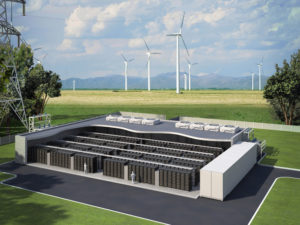The Most Powerful Wind Turbine in the World. And then some

Many of us stop at construction sites to watch a bit. This behavior often started when a small child. For one of my kids quite early on, it was a “mick-micker” (cement mixer truck) that fascinated her.
This video lasts 3:42.
From this YouTube come these facts:
- With a hub height of 135 m (443 ft), rotor diameter of 126 m (413 ft) and a total height of 198 m (650 ft), this large model can generate up to 7.58 megawatts of power per turbine. [This amount of MW should power more than 5,000 homes/yr.]
- The power output of the generator was changed from 6 MW to 7 MW after technical revisions were performed in 2009.
- The weight of the foundation of the turbine tower is about 2,500 t, the tower itself 2,800 t, the machine housing 128 t, the generator 220 t, the rotor (including the blade) 364 t. The total weight is about 6,000 t.
- The first turbine of this model was installed in Emden, Germany in 2007.
- The list price of one unit is $14 million plus install costs.
P.S. At the 3-minute mark, I found myself a bit a gasp due to a good case of acrophobia.
♦
Wonder if your blogger might offer something about wind energy for those who aren’t fascinated by a wind turbine construction video?
 How ‘bout the opportunity you may have missed to double your investment money last year–in wind energy companies? Yup. The stock price of the world’s biggest manufacturer and servicer of wind turbines, Vestas Wind Systems, doubled last year. So did the stock of its two biggest competitors.
How ‘bout the opportunity you may have missed to double your investment money last year–in wind energy companies? Yup. The stock price of the world’s biggest manufacturer and servicer of wind turbines, Vestas Wind Systems, doubled last year. So did the stock of its two biggest competitors.
What’s blowin’ such a metric? In several words: Wall Street, governments and falling manufacturing costs.
Financing for wind turbines has entered the realm of business-as-usual. In a post last December, I mentioned Goldman Sachs’ commitment to clean technology and renewable energy companies.
The federal government’s Clean Energy Plan, while stalled for now in the courts, is more regulation for the good of our worsening environment. It’s propelling utility companies to move increasingly to renewable energy sources. The federal Renewable Energy Production Tax Credit Plan is complementing falling costs of making renewable energy equipment as ordering ramps up further.
While a very conservative state, politically, Texas is the leading producer of wind-generated electricity across the U.S. No boundaries there as to energy production, political or otherwise.
The governments of China and India are also driving orders and reduced manufacturing costs.
Recent estimates indicate that wind and solar combined account for just about 6% of U.S. electricity generated. Coal accounts for about 39% with natural gas prices kicking the legs out from under coal–as well as by goals set by the federal government and many states aimed at reducing GHGs.
As writer Joby Warrick observed in a January 2016 Washington Post column, the U.S. has moved beyond the 70-gigawatt (70 billion watts) mark, sufficient to power 19M homes from 50K turbines.
Warrick reports on what may seem counter-intuitive in the energy industry: in spite of falling prices for fossil fuels, utility companies, as well as governments, are increasing their orders for renewable energy systems. The CEO of Vestas told Warrick that countries which are heavy importers of petroleum are using budget savings attributed to lower oil prices to invest in renewable energy infrastructure.
The rest of the renewable energy infrastructure needs to come from the likes of Elon Musk whose massive battery storage facility is soon to come online in Nevada. Duke Energy and Southern California Edison are among companies purchasing industrial-scaled battery storage for their wind farms.
